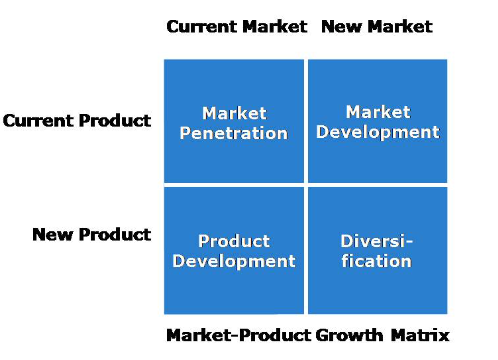
9.2.1 Market Penetration Strategies
This involves taking existing products into existing markets in order to obtain an increased share of the market. This can be achieved in two main ways:-
i) Increase sales to Existing customers - Advertising and promotion
ii) Find new customers in the same markets
The first strategy means persuading users to use more of the product on more occasions perhaps
by replacing an indirect competitor, e.g. If selling coffee – tell people coffee is also food at lunch. The second strategy, i.e. finding new customers in new markets requires the firm to take business directly from competitors by increasing both penetration and market share. This can also be achieved either by changing the product offering or by changing the positioning of the product in the market. Suggest – change product offering e.g. Mumias changing packaging to get smaller.
Market Penetration Strategies include:
i) Increase market share through competitive pricing, advertising and sales promotion
ii) Increase product share – e.g. By offering variety i.e Milk - yoghurt, fresh, butter
iii) Increase frequency of use
iv) Increase the quality and quantity used e.g. Dettol usage dose
v) Get new product applications
vi) Restructure a mature market by driving out
vii) Secure dominance of growth markets
2. Market Development Strategies
This entrails the marketing of current products to new customer groups and new regions.
It mainly deals with geographical expansions which is particularly appropriate when
important competitors are opening up new markets or when opportunities in new markets
will be available only for a short period of time. This is common in high-tech industries,
e.g. those dealing with computer and telecommunication services.
Geographic expansion may also become necessary when intense price competition in slow growth markets leads to less or declining profit margins. To achieve higher sales volumes, the company can introduce its products in new markets where few products modifications are required, e.g. Southern Sudan – people can take their packets to – Market development strategy.
The strategies of Market development include:
i) Expand markets for existing products
ii) Export products across Nutritional boundaries and engage in geographic expansion
iii) Target new customer groups and segments e.g. Financial Service – Traditional
Bank tries to target market of SACCOS by reducing interest rates and not requiring collateral
iv) Get new distribution channels to attract new customers e.g. Banks opening small offering services in Petrol stations and supermarkets
v) Make use of difference package sizes especially when dealing with foods and
other domestic items.
vi) Use differential pricing strategies to attract different types of customers and to create new market segments particularly when dealing with travel or airline services – e.g. 1st, 2nd class; Metro shuttle, etc.
3. Product Development Strategies
This involves a major modification of the foods or services in terms of quality, style and
performance. A company follows its basic strategy of product/market development, allocates resources to a limited number of markets and then focuses its existing operations on the development of new products in these areas.
This approach is appropriate if a company is well established in its markets and lacks the
motivation, ability or knowledge to adapt to a new environment. Product/Market Development is most appropriate when the current product market has matured the new products markets are growing fast in existing markets.
A car infrastructure for instance can offer high performance models to extend the ranges
to additional customers. The strategy has advantage of forcing competitors to innovate
and discouraging newcomers to the market or industry. However, the main disadvantage
is that it is time consuming, expensive and risky.
Product development strategies include:
i) Product improvements
ii) Product line extensions other versions
iii) Development new products for the same markets
4. Diversification Strategies
This option concerns, the development of new products for new markets. It is the most
option especially when the entry strategy issued based upon the core competencies of the
business. Source tobacco firms (e.g. BAT) have diversified to cosmetic and engineering
industries. There are two main strategies which include either vertical integration or
diversification. They can further be subdivided into the following:-
i) Vertical Integration Strategies
• Forward integration strategy
• Backward integration strategy
ii) Diversification Strategies
• Concentric/Related Diversification
• Unrelated/Conglomerate Diversification
Forward Integration occurs when a firm moves downstream in terms of the product flow
such as when a manufacture acquires a wholesale or retail outlet. Backward Integration
on the other hand occurs when a firm moves upstream by acquiring a supplier.
Vertical Integration has certain advantages:
• A firm secures supply of components or raw materials with more control and lowers the
bargaining power of the supplier.
• It strengthens the relationship and contracts of the infrastructure with the final
consumers in the market.
• The firm can achieve higher profit margins
• It enables a company to pursue a differentiation strategy more effectively
• It can raise entry barriers to the industry (bar others from entering/competing in the
industry).
Diversification Strategies
i) Concentric diversification: occurs when a firm internally develops or acquires
another business that might contribute to internal synergy than the sharing of
production facilities, brand names (e.g. Sera Lee – acquires Kiwi products), research and development known how and marketing and distributing skills (common with Coca Cola and Dasani).
ii) Conglomerate diversification on the other hand is the most risky of them all
because the firm involves completely its new areas and activities. It has the
following advantages:-
• The firm can spread risks against the future of current products and markets
• It can result in high profit and products flexibilities
Titany answered the question on
October 19, 2021 at 13:03